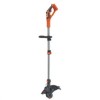Black & Decker LST136B Instruction Manual - Page 5
Acomponents - black decker
 |
View all Black & Decker LST136B manuals
Add to My Manuals
Save this manual to your list of manuals |
Page 5 highlights
• If battery contents come into contact with the skin, immediately wash area with mild soap and water. If battery liquid gets into the eye, rinse water over the open eye for 15 minutes or until irritation ceases. If medical attention is needed, the battery electrolyte for Li-ion batteries is composed of a mixture of liquid organic carbonates and lithium salts. 1. On/Off Switch COMPONENTS A 5 2 • Contents of opened battery cells may cause respiratory irritation. Provide fresh air. If symptoms persist, seek medical attention. 2. Handle 6 4 WARNING: Burn hazard. Battery liquid may be flammable if exposed to spark or flame. 3. Lock Off Button 1 • Charge the battery packs only in BLACK+DECKER chargers. 3 • DO NOT splash or immerse in water or other liquids. This may 4. Battery cause premature cell failure. • Do not store or use the tool and battery pack in locations where the temperature may reach or exceed 105°F (40˚C) (such 5. Charge Indicator as outside sheds or metal buildings in summer). WARNING: Never attempt to open the battery pack for any reason. If battery pack case is cracked or damaged, do not insert into charger. Do not crush, drop or damage battery pack. Do not use a battery pack or charger that has received a sharp blow, been dropped, run over or damaged in any way (i.e., pierced with a nail, hit with a hammer, stepped on). Damaged battery packs should be returned to service center for recycling. 6. Power Command 7. Auxillary Handle 8. Height Adjust 7 8 WARNING: Fire hazard. Do not store or carry battery so that metal objects can contact exposed battery terminals. For example, do Locking Clamp not place battery in aprons, pockets, tool boxes, product kit boxes, drawers, etc., with loose nails, screws, keys, etc. Transporting batteries can 9. Trimmer Head possibly cause fires if the battery terminals inadvertently come in contact with conductive materials such as keys, coins, hand tools and the like. The US Department of Transportation Hazardous Material 10. Edge Guide Regulations (HMR) actually prohibit transporting batteries in commerce or on airplanes (i.e., packed in suitcases and carry-on luggage) UNLESS they are properly protected from short circuits. So when transporting individual 11. Guard batteries, make sure that the battery terminals are protected and well insulated from materials that could contact them and cause a short circuit. NOTE: Batteries should not be put in checked baggage. 12. Spool Housing 5 9 11 10 12














